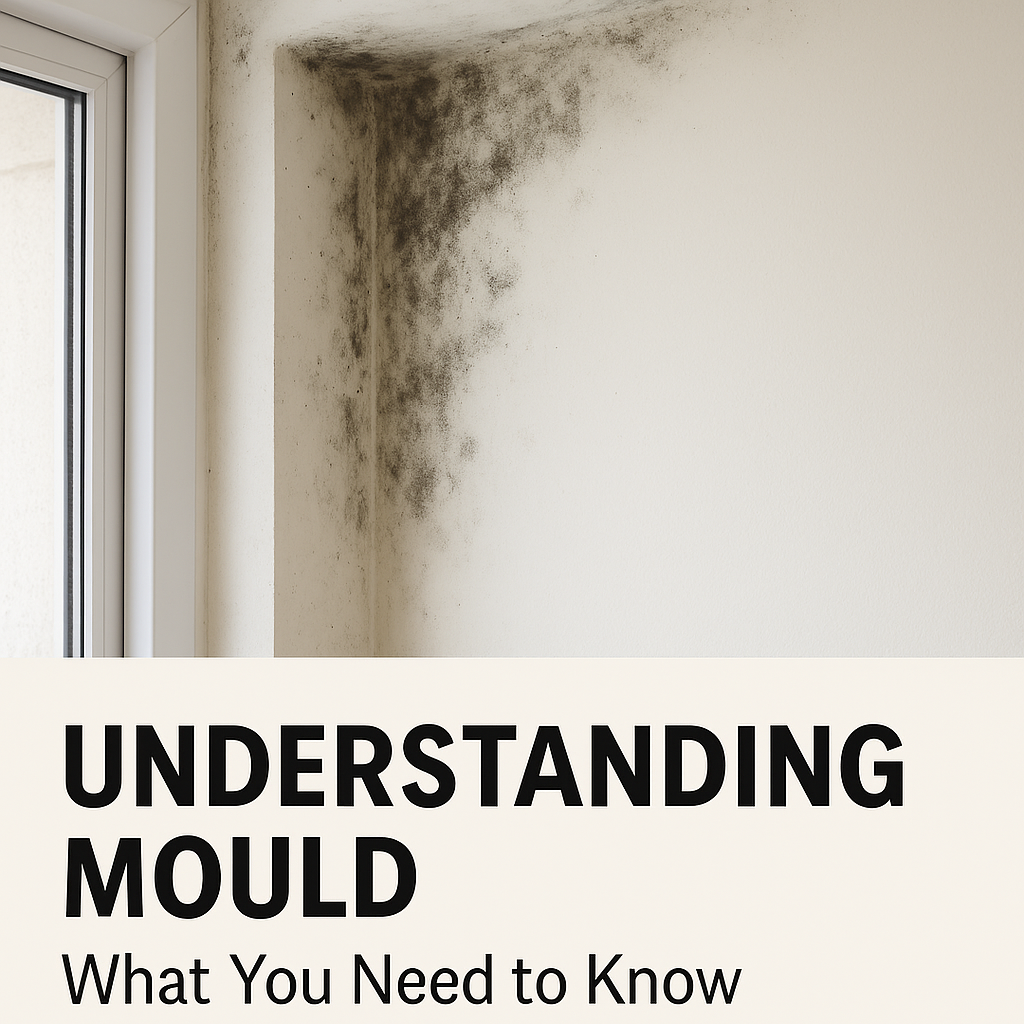Discover how to identify, prevent, and treat mould in your home. Learn what causes mould, where it grows, and how to protect your health and living space from moisture-related damage.

Disclaimer: this post may contain affiliate links, and every purchase made through these links will give me a small commission (at absolutely no extra cost for you!) AS AN AMAZON ASSOCIATE AND REWARDSTYLE MEMBER, I EARN FROM QUALIFYING PURCHASES. See Privacy Policy for additional info.
Mould may seem like a minor inconvenience at first glance, but it can quickly become a serious issue if left unchecked. From discolouring your walls to triggering respiratory problems, mould is more than just an unsightly stain—it’s a sign that excess moisture is taking hold in your home. Whether it's a slow leak behind the wall or high humidity levels in your bathroom, the conditions that lead to mould growth are often hidden, making early detection and prevention crucial.
Understanding how mould develops is the first step toward keeping your home healthy and safe. It thrives in damp, poorly ventilated areas such as bathrooms, kitchens, basements, and even around windows. And while the occasional spot may be easy to clean, the underlying cause—usually some form of trapped moisture—must be addressed to prevent recurring infestations. Ignoring mould can lead to structural damage and health concerns, especially for those with allergies, asthma, or other respiratory issues.
The good news? Most mould problems can be managed with the right knowledge and tools. In this guide, we’ll break down everything you need to know about mould: where it’s most likely to appear, how to prevent it, what products can help, and when it’s time to call in a professional. By staying proactive, you can protect your home and your family from the long-term effects of mould exposure.
Understanding Mould: What You Need to Know
Mould is one of those pesky home invaders that can wreak havoc, not just on the aesthetics of your living space but also on your health. It thrives in damp environments, making areas like bathrooms, kitchens, and basements its playground.
When you spot those dark spots creeping up the walls or ceiling, it's more than just a visual nuisance, it's a signal that a problem needs addressing. But what causes mould? The primary culprit is moisture.
Whether it's a small leak, high humidity, or condensation, any excess moisture can lead to mould growth, fundamentally affecting air quality and potentially leading to health issues like allergies or respiratory problems. Understanding these conditions and proactively tackling moisture can help keep your home safe and healthy.
Curious about how to keep moisture under control in your home? Don’t miss my post on How to Prevent Bathroom Mold and Mildew Naturally—it's packed with easy, non-toxic tips to keep one of the most mould-prone areas fresh and clean!
Identifying Mould-Prone Areas in Your Home
Certain areas in your home are more susceptible to mould than others. It’s essential to conduct regular checks, especially in the following spots:
Bathrooms
Due to the steam and humidity, bathrooms are prime targets for mould growth. Pay special attention to corners of showers, bathtubs, and around sinks.
Kitchens
The kitchen is another hotspot. Grease and food remnants can trap moisture, creating an environment conducive to mould. In addition to cleaning up spills promptly, keep an eye on your fridge and any hidden damp spots.
Basements and Crawl Spaces
Basements are notorious for dampness, especially if they are unfinished. Installing a dehumidifier can be a great first step in preventing mould. Also, ensure that your crawl spaces are adequately ventilated.
Windows and Walls
Condensation on windows during colder months can foster mould. Inspect the seals on your windows and ensure they are watertight. If you notice condensation frequently, consider using window insulation to minimize the moisture.
Preventing Mould: Practical Solutions
Once you’ve identified the vulnerable spots in your home, it’s crucial to implement practical solutions. The following tips can help pave the way for a mould-free environment:
Ventilation
Increase airflow in rooms prone to humidity. Use exhaust fans in bathrooms and kitchens and consider opening windows when weather permits. Cross-ventilation is often an overlooked yet effective way to combat dampness.
Humidity Control
Installing a dehumidifier, particularly in basements, can help keep moisture levels in check. Aim for a relative humidity level below 60%. If you live in a particularly humid climate, this could be essential.
Regular Cleaning
Regular cleaning prevents mould from taking hold. Focus on high-humidity areas, using non-toxic cleaning solutions to manage residues that could retain moisture.
Moisture-Resistant Materials
For regions that are especially prone to mould, consider using moisture-resistant materials. This can include mould-resistant paints, drywall, and even furniture that is designed to withstand damp environments.
Utilizing Effective Cleaning Products
Sometimes, despite our best efforts, mould may still appear. That’s when it's time to turn to effective cleaning products like the mould remover. Formulated to tackle those stubborn stains, this product works on various surfaces, effectively eliminating mould and mildew without requiring excessive scrubbing.
Recognizing the Signs of Mould Infestation
Even the most diligent among us can occasionally overlook mould’s early signs. Knowing what to look for can help in early detection:
Visible Signs
Black or green spots on walls and ceilings are often the most obvious indicators. If you see dark patches, particularly in corners or near water sources, it's time to take a closer look.
Musty Odours
If you start to notice a persistent musty smell, it might be wafting from hidden mould colonies. Trust your senses—odours often come before visual signs, signaling that dampness may be an issue.
Health Symptoms
Often, a mould-filled home can affect your health. Symptoms may include coughing, sneezing, skin irritation, or even chronic fatigue. If household members show symptoms that worsen indoors, consider investigating for mould.
Your Action Plan: How to Tackle Mould Once Found
If you have confirmed the presence of mould, it’s essential to act promptly. Ignoring the problem won't make it disappear. Here’s a step-by-step process to tackle mould once you find it:
Assess the Extent
Before diving in, take stock of the situation, how much area has been affected? If mould is confined to smaller areas, you may be able to tackle it yourself. If it has spread widely or is behind walls, it might be time to consult a professional.
Personal Safety First
When cleaning mould, prioritize your safety. Use gloves, masks, and eye protection to avoid inhaling spores or coming into contact with mould.
Cleaning the Area
After taking safety precautions, use your chosen mould remover to clean the area. For small patches, a simple scrub with the mould remover can do wonders, while larger infestations may require more extensive measures, including replacing affected materials.
Prevent Future Growth
After cleaning, these areas require monitor and ongoing maintenance. Regularly check for moisture accumulation, keep the areas well-ventilated, and use your dehumidifier to ensure moisture levels remain manageable.
Creating a Habit of Home Maintenance
Finally, the best way to combat mould growth is through consistent home maintenance. Establish a habit of occasionally auditing your home’s moisture levels, cleaning up spills, and checking for leaks. Make it a family effort, assign different areas for each family member to maintain.
This not only takes the burden off one person but also teaches children the importance of maintaining a healthy living space. Incorporating these practices not only enhances your quality of life but also ensures your home remains a sanctuary for you and your family. With a little diligence and the right tools, a happy, mould-free home is entirely achievable!
Want more home maintenance tips and solutions? Check out my latest posts over on Nikki’s Plate for practical advice on keeping your home clean, safe, and healthy year-round!









Leave a Reply